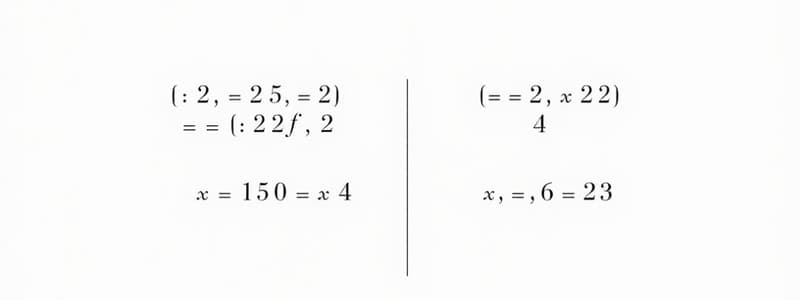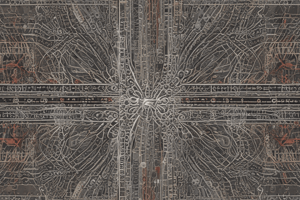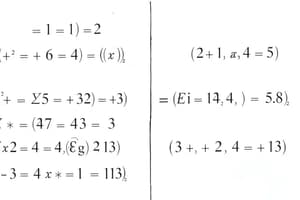Podcast
Questions and Answers
What are inverse operations?
What are inverse operations?
- Operations that do not affect each other
- Operations that always produce a larger number
- Operations that can only be used in pairs
- Operations that 'undo' one another (correct)
What does the Addition Property of Equality state?
What does the Addition Property of Equality state?
Adding the same number to each side of an equation produces an equivalent equation.
What does the Subtraction Property of Equality state?
What does the Subtraction Property of Equality state?
Subtracting the same number from each side of an equation produces an equivalent equation.
What does the Multiplication Property of Equality state?
What does the Multiplication Property of Equality state?
What does the Division Property of Equality state?
What does the Division Property of Equality state?
What is an Absolute Value Equation?
What is an Absolute Value Equation?
What is the definition of Absolute Value?
What is the definition of Absolute Value?
What is the formula for the Area of a Triangle?
What is the formula for the Area of a Triangle?
What is the formula for the Area of a Trapezoid?
What is the formula for the Area of a Trapezoid?
What is Perimeter?
What is Perimeter?
What is the formula for the Circumference of a circle?
What is the formula for the Circumference of a circle?
What is the formula for the Area of a Parallelogram?
What is the formula for the Area of a Parallelogram?
What is the formula for the Volume of a Prism?
What is the formula for the Volume of a Prism?
What is the formula for the Volume of a Pyramid?
What is the formula for the Volume of a Pyramid?
What is the formula for the Volume of a Cylinder?
What is the formula for the Volume of a Cylinder?
What is the formula for the Volume of a Cone?
What is the formula for the Volume of a Cone?
What is a Literal Equation?
What is a Literal Equation?
What is the formula for the Surface Area of a Cone?
What is the formula for the Surface Area of a Cone?
What is the Power of a Quotient Property?
What is the Power of a Quotient Property?
Flashcards are hidden until you start studying
Study Notes
Inverse Operations
- Inverse operations are actions that reverse each other, aiding in solving equations.
- Key pairs include: addition and subtraction, multiplication and division.
Properties of Equality
- Addition Property of Equality: Adding the same number to both sides maintains equivalence.
- Subtraction Property of Equality: Subtracting the same number from both sides maintains equivalence.
- Multiplication Property of Equality: Multiplying both sides by the same number maintains equivalence.
- Division Property of Equality: Dividing both sides by the same number maintains equivalence.
Absolute Value
- Absolute Value Equation: An equation featuring an absolute value expression, indicating distance from zero.
- Absolute Value: Represents the distance of a number from 0 on the number line.
Geometric Formulas
- Area of a Triangle: A = 0.5 * b * h (where b is base and h is height).
- Area of a Trapezoid: A = 0.5 * (b1 + b2) * h.
- Perimeter: Total distance around a figure, calculated by adding all side lengths.
- Circumference of a Circle: C = 2𝛑r or C = 𝛑d (where r is radius and d is diameter).
- Area of a Parallelogram: A = b * h (base times height at a right angle to the base).
- Volume of a Prism: V = l * w * h (length times width times height).
- Volume of a Pyramid: V = (1/3) * B * h (where B is the base area).
- Volume of a Cylinder: V = 𝛑 * r² * h (where r is radius and h is height).
- Volume of a Cone: V = (1/3) * 𝛑 * r² * h (where r is radius and h is height).
- Surface Area of a Cone: S = 𝛑r² + 𝛑rℓ (includes base and lateral surface area, where ℓ is slant height).
Literal Equations
- A literal equation contains two or more variables, used to express relationships between quantities.
Power of a Quotient Property
- The power of a quotient is calculated by individually raising the numerator and denominator to the power before dividing them.
Studying That Suits You
Use AI to generate personalized quizzes and flashcards to suit your learning preferences.




